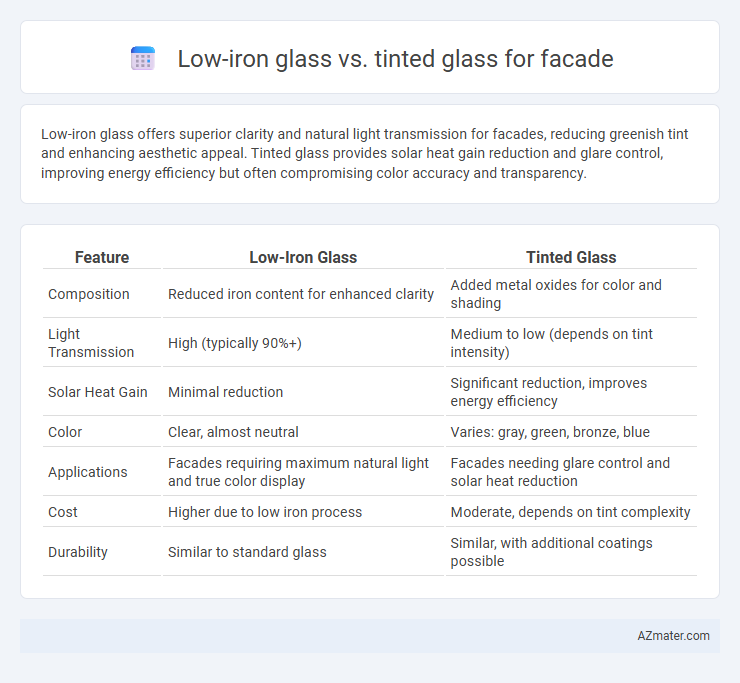Low-iron glass offers superior clarity and natural light transmission for facades, reducing greenish tint and enhancing aesthetic appeal. Tinted glass provides solar heat gain reduction and glare control, improving energy efficiency but often compromising color accuracy and transparency.
Table of Comparison
| Feature | Low-Iron Glass | Tinted Glass |
|---|---|---|
| Composition | Reduced iron content for enhanced clarity | Added metal oxides for color and shading |
| Light Transmission | High (typically 90%+) | Medium to low (depends on tint intensity) |
| Solar Heat Gain | Minimal reduction | Significant reduction, improves energy efficiency |
| Color | Clear, almost neutral | Varies: gray, green, bronze, blue |
| Applications | Facades requiring maximum natural light and true color display | Facades needing glare control and solar heat reduction |
| Cost | Higher due to low iron process | Moderate, depends on tint complexity |
| Durability | Similar to standard glass | Similar, with additional coatings possible |
Introduction to Facade Glass Types
Low-iron glass features high clarity and enhanced light transmission, making it ideal for facades where natural brightness and true color display are crucial. Tinted glass provides solar control by reducing glare and heat gain, contributing to energy efficiency and occupant comfort in building exteriors. Selecting between low-iron and tinted glass depends on balancing visual transparency with thermal performance requirements in architectural facades.
What is Low-Iron Glass?
Low-iron glass, characterized by its minimal iron content (usually less than 0.03%), offers superior clarity and transparency compared to standard tinted glass, making it ideal for facades that demand maximum natural light and true color visibility. Unlike tinted glass, which contains added colorants to reduce solar heat and glare, low-iron glass maintains high light transmission with a neutral appearance, enhancing architectural aesthetics without compromising thermal performance. This clarity advantage ensures facades with low-iron glass appear brighter and more vibrant, optimizing daylighting while supporting energy efficiency when paired with appropriate coatings.
What is Tinted Glass?
Tinted glass is a type of glass infused with additives like metal oxides during manufacturing to reduce solar heat gain and glare by absorbing a portion of sunlight. It offers enhanced energy efficiency for building facades by lowering cooling costs and improving occupant comfort through UV protection. Compared to low-iron glass, which prioritizes high clarity and minimal color distortion, tinted glass provides more effective shading and privacy benefits in commercial and residential applications.
Visual Clarity and Aesthetics
Low-iron glass offers superior visual clarity compared to tinted glass due to its reduced iron content, resulting in minimal greenish hues and enhanced natural light transmission, making it ideal for vibrant and true-to-color facades. Tinted glass, while providing glare reduction and solar control, often compromises transparency and can introduce color distortions that affect the building's overall aesthetic appeal. For architectural facades prioritizing a crisp, clear appearance with maximum daylighting, low-iron glass remains the preferred choice over tinted alternatives.
Light Transmission Comparison
Low-iron glass offers superior light transmission, typically allowing around 91-92% of visible light to pass through, making it ideal for facades requiring maximum natural illumination. In contrast, tinted glass reduces light transmission significantly, often permitting only 40-60%, which helps in glare reduction and solar heat gain control but sacrifices daylight intensity. Choosing between low-iron and tinted glass directly impacts energy efficiency and occupant comfort by balancing light performance with thermal control in building facades.
Energy Efficiency and Solar Control
Low-iron glass offers superior clarity and light transmission, enhancing natural daylight while reducing the need for artificial lighting, which improves overall energy efficiency in building facades. Tinted glass provides effective solar control by reducing solar heat gain, minimizing cooling loads, and enhancing occupant comfort in warm climates. Combining low-iron glass with advanced coatings optimizes both visible light transmittance and solar heat rejection, resulting in balanced energy performance and occupant satisfaction.
Impact on Indoor Comfort
Low-iron glass enhances indoor comfort by maximizing natural daylight while minimizing color distortion, creating a brighter and more visually appealing interior environment. Tinted glass reduces solar heat gain effectively, leading to cooler indoor temperatures and decreased reliance on air conditioning systems. Balancing daylight transmission and solar control in facade applications directly influences occupant well-being and energy efficiency.
Cost Differences
Low-iron glass typically costs 20-40% more than standard tinted glass due to its higher silica purity and clarity, enhancing natural light transmission in facades. Tinted glass offers a more budget-friendly option by reducing solar heat gain and glare but compromises on visible light clarity. The choice between low-iron and tinted glass for facades significantly impacts overall project cost, balancing upfront expenditure with long-term energy efficiency benefits.
Environmental Considerations
Low-iron glass offers superior clarity and light transmission, reducing the need for artificial lighting and lowering energy consumption in building facades. Tinted glass decreases solar heat gain, enhancing thermal performance and reducing cooling costs in warm climates. Selecting between low-iron and tinted glass depends on balancing natural daylight optimization with energy efficiency goals for sustainable building design.
Choosing the Right Glass for Your Facade
Low-iron glass offers superior clarity and higher light transmission, making it ideal for facades requiring natural daylight with minimal color distortion, while tinted glass reduces solar heat gain and glare, enhancing energy efficiency and occupant comfort. Selecting the right glass depends on balancing aesthetics, light performance, thermal properties, and energy savings specific to the building's design and climate. Consider factors such as U-value, solar heat gain coefficient (SHGC), visible light transmittance (VLT), and project location to optimize facade performance and occupant experience.

Infographic: Low-iron glass vs Tinted glass for Facade
 azmater.com
azmater.com